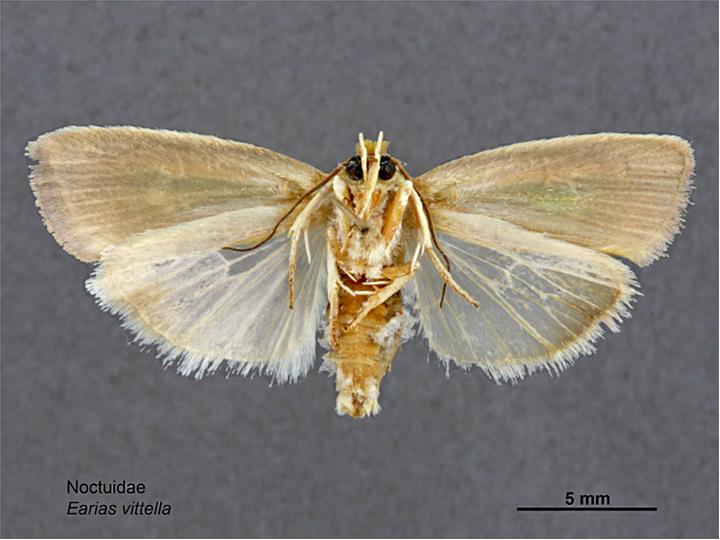Spotted Bollworm

Caused by insect
Factors –
a- Wilting of terminal shoots before flowering.
b- Shedding of squares and bolls.
c- Holes in bolls and rotten inside.
d- Cotton bolls may gradually become empty.
Hosting body – cotton
Identifiable traits
These larvae mainly attack bolls, but also feed on squares, shoots and flowers if bolls are not present. If infested during the vegetative state, the caterpillars feed through the terminal buds of the shoots and move downward. This causes drying and shedding of terminal shoots before flowering. If the main stem is affected, the larvae will feed on flower buds and bolls, entering through holes bored around the base. Damaged flower buds sometimes spread prematurely, resulting in so-called ‘flared squares’. The damage to plant tissue and presence of excrement lead to colonization by fungal or bacterial infections, worsening the symptoms. The younger the plant is when it is attacked, the more damage this pest can cause. Alternative host plants for this pest are, among others, hibiscus and okra.
Inducing factors
Damage is caused by the larvae of the spotted bollworm, Earias vittella, a common pest in the southern regions of India. The moths are mostly pale with green features, approximately 2 cm long and can be found on flowers or close to light sources. The forewings are pale with bright green streaks, the hind-wings are silky-white suffused with pale brownish-grey. Eggs are blue in color and laid singly on young shoots, leaves and squares. The young larvae is light brown with grey to green features, and pale along the mid dorsal line, fully grown larvae are up to 1.8 cm long. Tiny spines, visible under a hand lens, cover most of the body surface. As they reach maturity, they pupate in a silken cocoon attached to larvae or fallen plant parts. Under tropic conditions, a generation is complete within 20-25 days. Low temperatures can delay the process for up to two months.

Organic remedies
Searching scouting for eggs or small larvae is crucial in the management of this pest. Some parasitoid insects of the family Braconidae, Scelionidae and Trichogrammatidae can be used biological control method. Also try predatory insects from the following orders: Coleoptera, Hymenoptera. Hemiptera and Neuroptera. Make sure to promote these species and avoid use of broad-scale pesticides. You can apply bioinsecticide sprays containing Bacillus Thuringiensis to control population peaks. Spray neem seed kernel extrack (NSKE) 5% or neem oil (1500 ppm) @ 5ml/L.
Chemical remedies
Always consider an integrated approach with preventive measures together with biological treatments. If available. Treatment is recommended when 10 eggs or five small worms per 100 plants are present during early bloom. As larvae become increasingly resilient to insecticidal treatment while growing, scouting for eggs and young larvae is crucial. Treatment is recommended to be applied during egg stage. Insecticides containing chlorantraniliprole, emamectin benzoate, flubendiamide, methomyl or esfenvalerate can be applied. Chemical treatment may be enviable in low value crops.
Extra remedies
Plant resilient varieties, f available in your locality/area. Ensure early planting to avoid peak populations. Leave sufficient distance between plants. Provide uncultivated marginal areas to break life cycle. Plant trap crops like hibiscus and okra. Avoid monocultures and implement intercropping with beneficial plants. Monitor the cotton field regularly for larvae and eggs of the spotted bollworm. Keep up a sufficient fertilization. Promote practices that bring and early harvest. Clear all harvest residue after each cropping cycle. Plough deeply to expose pupae to predators and elements.
We will keep posting about any such informative information on to our blogs, to help as many people as possible. Farmonaut is built upon a vision to bridge the technological gap between farmers and strives to bring state-of-the-art technologies in the hands of each and every farmer. For any queries/suggestions, please contact us at support@farmonaut.com.
We have some more interesting articles coming up soon. Stay tuned!
Wait!!
Before that…
Follow us at:
Facebook: https://facebook.com/farmonaut
Instagram: https://instagram.com/farmonaut
Twitter: https://twitter.com/farmonaut
LinkedIn: https://www.linkedin.com/company/farmonaut/
Pinterest: https://in.pinterest.com/farmonaut/
Tumblr: https://farmonaut.tumblr.com/
Youtube: https://www.youtube.com/channel/UCYWOOPPKATLgh4L6YRlYFOQ
AppLink: https://play.google.com/store/apps/details?id=com.farmonaut.android
Website: https://farmonaut.com
Satellite Imagery: https://farmonaut.com/satellite-imagery
Satellite Imagery Samples: https://farmonaut.com/satellite-imagery-samples












